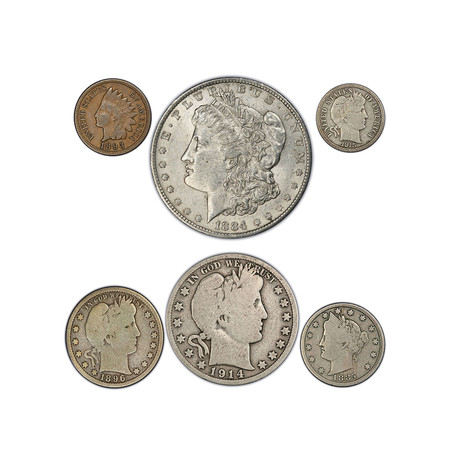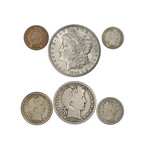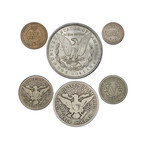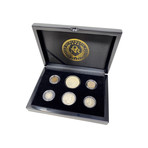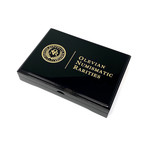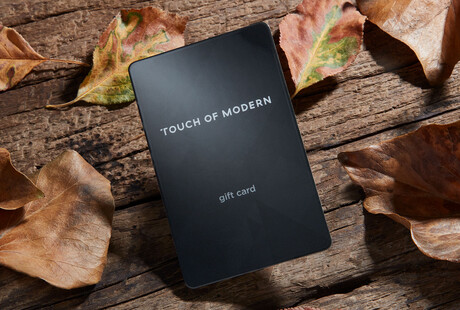Olevian Numismatic Rarities
Late 19th & Early 20th Century American 6-Coin Type Set // Relics of a Bygone Era Series // Wood Presentation Box
Product Description
This classic 6-coin set features some of the most famous designs to ever grace United States coinage during the late 19th and early 20th centuries. Each set includes one Indian cent, Liberty nickel, Barber dime, Barber quarter, Barber half dollar, and Morgan dollar minted between 1870 and 1916. The coins for this special offer were hand-selected by professional numismatists after screening thousands of collectible coins for quality and eye-appeal. They span a period beginning with the radical political and civil rights issues of post-Civil War Reconstruction, through the rapid economic growth and industrialization of the Gilded Age, and ending during the height of World War I. More than 100 years after their last mintage, these coins continue to be among the most beloved in American history. Each coin is housed in an airtight capsule and the set is presented in a luxurious, plush-lined wood box with embossed metallic gold lettering, piano-black finish, and certificate of authenticity. The coins are unconditionally guaranteed to be genuine and will match the quality of the ones shown.
In the first half of the 18th century, one cent coins were large, clunky copper pieces nearly the size of a modern half dollar. By 1856, the cost of producing these copper coins rose so high that the U.S. mint was forced to significantly reduce the size of the one cent coin. On May 25th, 1857 the mint debuted a new small diameter cent, the Flying Eagle cent, which was the same size as our modern-day Lincoln cent. However, due to difficulties in production and issues with strike quality, this new cent was quickly abandoned and replaced by the Indian Head cent, which was minted through 1909. The obverse of the Indian Head cent features Lady Liberty wearing a Native American war bonnet— regarded by the public at the time as a decidedly unusual headdress for a female figure of otherwise neoclassical Greek form. The reverse originally featured an olive wreath, which was later changed to a wreath of oak and other leaves with a shield at the apex. Indian cents remained in circulation through the 1940s until increasing value and interest among coin collectors rendered them scarce by 1950.
The Liberty Head nickel was the second 5-cent coin to be struck in that metal, following the Shield nickels of 1866-1883. When introduced in January of 1883, the reverse featured a Roman numeral V to indicate the 5-cent denomination. The inclusion of the word “cents” was never considered necessary, as the three-cent piece had circulated uneventfully for years with only Roman numerals. It quickly became apparent, however, that the omission of “cents” was a serious issue, as many people began gold plating the new nickels and passing them as five-dollar gold pieces, which had a similar size. A famous tale was that of Jeff Tatum, a deaf-mute who was said to enter a store, purchase an item valued at 5 cents or less, and pay with a gold-plated nickel. If the clerk did not notice, he would erroneously be given $4.95 in change. It is said that such was the origin of the expression “just Joshing you!” Regardless, the U.S. Mint was particularly disturbed by the gold-plated nickels and ordered a design modification by June of 1883 to include the word “cents.” The Liberty nickel was produced in this fashion through 1913. Only 5 specimens are known to exist from this last year, making the 1913 nickel one of the most famous and coveted rarities in American numismatics. Indeed, one of these coins sold for over five million dollars in 2007! The coin set offered here is your opportunity to own a decidedly more modest but still interesting example of this important piece of American history.
By 1891, the public had grown weary of the Seated Liberty coinage that had clinked in their pockets for over 50 years. Consequently, U.S. Mint director Leech instructed Chief Engraver Charles E. Barber to prepare designs for the coins that now bear his name. The result was a new dime, quarter, and half dollar rendered in a distinctly neoclassical Roman design that drew influence from contemporary French coinage circulating in Europe. The Barber obverse features Liberty, facing right, wearing an olive branch crown termed a pileus, as well as a headband inscribed with LIBERTY. The Barber dime reverse design shows a wreath encircling the denomination, like that of the Seated Liberty dime, but different from the Barber quarter and half dollar. The reverse of these two coins depict a heraldic eagle with shield, modeled after the Great Seal of the United States. It holds a scroll in its beak inscribed with E PLURIBUS UNUM as well an olive branch and arrows in its talons—symbolic of a peaceful nation but one that is poised for war. Above the eagle are 13 stars representing the original colonies, the name of the country, and the denomination. Barber coins were produced from 1892 through the middle of the first World War in 1916, except for the half dollar, which ended one year earlier. This famous trio was a staple in American commerce for generations until silver coins were mostly hoarded from circulation by the late 1960s.
Named after the designer, U.S. Mint Assistant Engraver George T. Morgan, this coin was produced from 1878 to 1904 and again in 1921. The obverse of the coin depicts Liberty as a youthful woman wearing a Phrygian cap, originally worn by emancipated slaves of ancient Rome, together with a headdress of cotton and wheat— staples of the U.S. economy. The reverse features an American bald eagle with outstretched wings, symbolic of the power of the U.S. government. The eagle bears in its great talons both an olive branch and 3 arrows, representing a nation of peace but one that is poised for war. The dollar was authorized by the passage of the Bland-Allison Act in 1878, which required the Treasury to purchase an enormous 2 to 4 million dollars’ worth of silver each month to be coined into dollars. Later, in 1918, passage of the Pittman Act ultimately led to the melting of over 270 million Morgan dollars held in treasury reserves. Today, the choice few that remain are cherished specimens of a bygone era that serve to immortalize the memory of a young, prosperous, and powerful United States of America.
Product Details
- Measurements
8"L x 6"W x 2"H
- OriginUnited States
Coin 1:
— Type: Indian Cent (1859-1909)
— Variety: Copper (1864-1909)
— Designer: James B. Longacre
— Weight: 3.11 grams
— Diameter: 19 mm
— Composition: 0.950 copper, 0.50 tin and zinc
— Obverse Design: Lady Liberty with feathered headdress, facing left
— Obverse Inscription: UNITED STATES OF AMERICA / DATE
— Reverse Design: Oak wreath and shield
— Reverse Inscription: ONE CENT
Coin 2:
— Type: Liberty Nickel (1883-1913)
— Designer: Charles E. Barber
— Weight: 5.00 grams
— Diameter: 21.2 mm
— Composition: 75% Copper, 25% Nickel
— Obverse Design: Lady Liberty, facing left, with coronet, cotton, and wheat / 13 stars
— Obverse Inscription: DATE
— Reverse Design: Wreath of cotton, wheat, and corn
— Reverse Inscription: UNITED STATES OF AMERICA / E PLURIBUS UNUM / V CENTS
Coin 3:
— Type: Barber Dime (1892-1916)
— Designer: Charles E. Barber
— Weight: 2.5 grams
— Diameter: 17.9 mm
— Composition: 0.900 silver, 0.100 copper
— Net silver weight: 0.07234 oz pure silver
— Obverse Design: Liberty, facing right, with pileus and headband
— Obverse Inscription: UNITED STATES OF AMERICA / LIBERTY / DATE
— Reverse Design: Wreath of corn, wheat, maple, and oak
— Reverse Inscription: ONE DIME
Coin 4:
— Type: Barber Quarter (1892-1916)
— Designer: Charles E. Barber
— Weight: 6.25 grams
— Diameter: 24.3 mm
— Composition: 0.900 silver, 0.100 copper
— Net silver weight: 0.18084 oz pure silver
— Obverse Design: Liberty, facing right, with pileus and headband / 13 stars
— Obverse Inscription: IN GOD WE TRUST / LIBERTY / DATE
— Reverse Design: Heraldic eagle with shield, scroll, olive branch, and 13 arrows / 13 stars
— Reverse Inscription: UNITED STATES OF AMERICA / E PLURIBUS UNUM / QUARTER DOLLAR
Coin 5:
— Type: Barber Half Dollar (1892-1915)
— Designer: Charles E. Barber
— Weight: 12.5 grams
— Diameter: 30.0 mm
— Composition: 0.900 silver, 0.100 copper
— Net silver weight: 0.36169 oz pure silver
— Obverse Design: Liberty, facing right, with pileus and headband / 13 stars
— Obverse Inscription: IN GOD WE TRUST / LIBERTY / DATE
— Reverse Design: Heraldic eagle with shield, scroll, olive branch, and 13 arrows / 13 stars
— Reverse Inscription: UNITED STATES OF AMERICA / E PLURIBUS UNUM / HALF DOLLAR
Coin 6:
— Type: Morgan Dollar (1878-1904, 1921)
— Designer: George T. Morgan
— Weight: 26.73 grams
— Diameter: 38.1 mm
— Composition: 0.900 silver and 0.100 copper
— Net silver weight: 0.77344 oz pure silver
— Obverse Design: Liberty with Phrygian Cap and headdress of cotton and wheat / 13 stars
— Obverse Inscription: E PLURIBUS UNUM / LIBERTY / DATE
— Reverse Design: Eagle with outstretched wings, bearing an olive branch and arrows in talons / Wreath
— Reverse Inscription: UNITED STATES OF AMERICA / IN GOD WE TRUST / ONE DOLLAR
Please Note: The item(s) you receive will match the quality of the one shown, but may vary slightly due to the nature of original historical artifacts.
Shipping Information
-
Shipping AvailabilityCanada, United States
-
Shipping PolicyStandard Ground Shipping
-
Ship In2-3 weeks ⓘ
-
Return PolicyFinal sale, not eligible for return or cancellation
